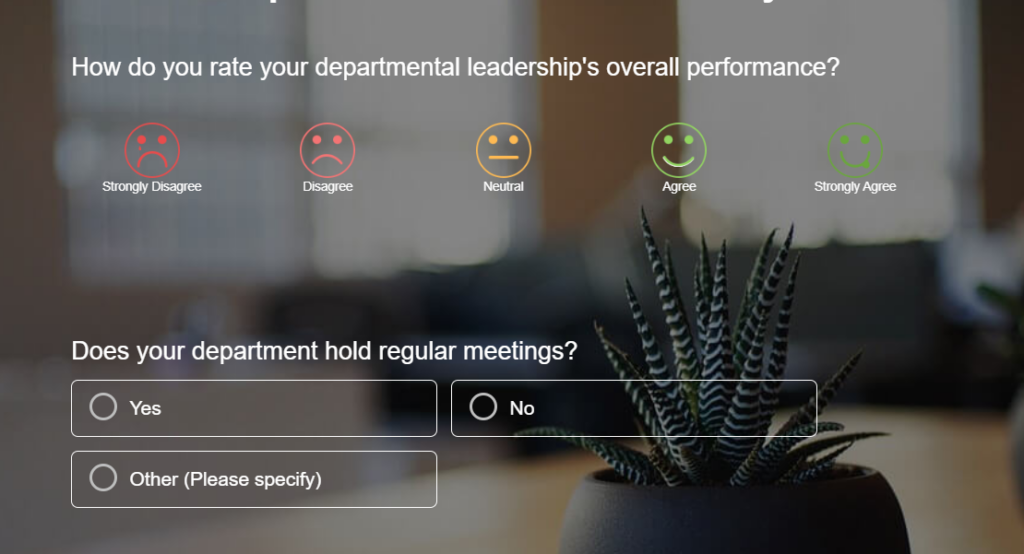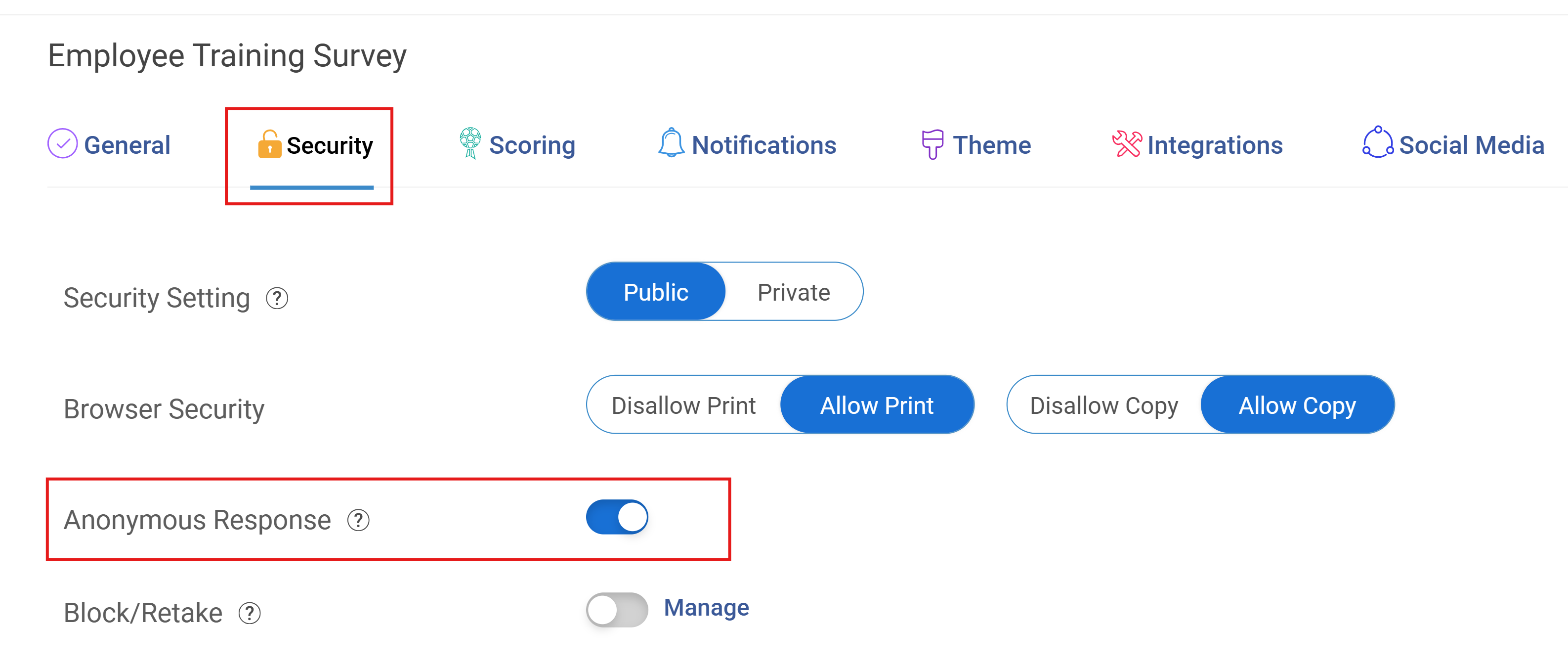We know that employee surveys are the best way to know how employees feel about their work. But why should they be anonymous? Well, anonymous employee surveys are crucial because, more often than not, employees hold back on giving their true opinions for fear of repercussions.
When there are no such barriers and employees are sure that their responses cannot be traced back to them, you are much more likely to gain raw and unfiltered feedback. You can get insights into areas that really matter and can impact your business.
In this blog, we will explore these surveys in detail – definition, types, examples, tips, and more.
Let’s begin with a general tutorial on creating an employee engagement survey.
Watch: How to Create Awesome Employee Engagement Surveys: 6 Quick Tips
What Is an Anonymous Survey & What Are its Benefits?
An anonymous survey is a research method that allows individuals to provide feedback without revealing their identity. This means no personal information, such as names, email addresses, or IP addresses, is collected that could link responses to a specific person.

Why is anonymity important?
Anonymity encourages honesty and openness, particularly when dealing with sensitive or potentially controversial topics. When respondents know their answers cannot be traced back to them, they are more likely to share their true thoughts and feelings without fear of judgment or repercussions. This leads to more accurate data and more effective decision-making.
Key characteristics of an anonymous survey:
- No collection of personal information: This includes any identifying details that could link a response to an individual.
- Confidential responses: Responses are stored securely and cannot be traced back to specific participants.
- Clear communication about anonymity: Participants must be explicitly informed that the survey is anonymous to ensure transparency and build trust.
Benefits of using anonymous surveys:
- Increased honesty and openness: Participants feel safe to express their true opinions without fear of consequences.
- Higher response rates: Anonymity can encourage greater participation, leading to more comprehensive data.
- Reduced bias: Anonymity can minimize social desirability bias, where respondents may provide answers they believe are more socially acceptable.
Common use cases for anonymous surveys:
- Employee feedback: Gathering honest feedback on workplace culture, management practices, and job satisfaction.
- Customer satisfaction: Understanding customer experiences and identifying areas for improvement.
- Sensitive topics: Researching potentially sensitive topics where anonymity is crucial for honest responses.
By providing anonymity, you create a safe space for individuals to share their thoughts and feelings openly and honestly. This leads to more accurate data, better insights, and, ultimately, more informed decisions.
20+ Anonymous Survey Question Examples to Ask Your Employees
Here are 20+ questions to include in your anonymous employee survey:
Job Satisfaction & Engagement
- On a scale of 1 to 5, how satisfied are you with your current role and responsibilities?
- How often do you feel engaged and motivated at work?
- Do you feel your skills and abilities are being utilized effectively?
- What do you enjoy most about your job?
- What are the biggest challenges you face in your current role?
Company Culture & Values
- How would you describe the company culture in your own words?
- Do you feel the company values are reflected in day-to-day work?
- Do you feel a sense of belonging and inclusion at work?
- What could the company do to improve its culture?
Management & Leadership
- How effectively does your manager communicate with you?
- Do you feel supported and valued by your manager?
- Does your manager provide you with opportunities for growth and development?
- How could management improve its leadership style?
Work-Life Balance & Benefits
- On a scale of 1 to 5, how would you rate your work-life balance?
- Do you feel the company supports a healthy work-life balance?
- How satisfied are you with the company’s benefits package?
- Are there any benefits you wish the company offered?
Compensation & Recognition
- Do you feel your compensation is fair for the work you do?
- Do you feel valued and appreciated for your contributions?
- How could the company improve its recognition and rewards program?
Open-Ended Questions
- What are your suggestions for improving communication within the company?
- What could the company do to improve employee morale and engagement?
- What are your thoughts on the company’s approach to diversity and inclusion?
- Do you have any other feedback or suggestions you would like to share?
| Important Notes:
Customize: Adapt these questions to your specific needs and company culture. |
How to Create an Anonymous Survey for Employees
We have taken ProProfs Survey Maker as an example for the step-by-step guide:
1. Ensure Anonymity Settings are Enabled
- Access Survey Settings: When creating or editing your survey, navigate to the “Settings” tab.
- Enable “Anonymous Responses”: Toggle this setting to “Enable” to ensure no identifying information is collected from respondents.

2. Design Your Survey for Anonymity
- Avoid asking identifying questions: Refrain from asking for names, email addresses, employee IDs, departments, or locations.
- Use broad demographics (if needed): If you need some demographic data, ask general questions like “How long have you been with the company?” with broad ranges as answer options.
- Phrase questions carefully: Avoid questions that could indirectly reveal someone’s identity.
- Keep it concise: Aim for a survey that takes no more than 15-20 minutes to complete.
3. Communicate Anonymity Clearly
- Add an introductory message: Begin your survey with a clear statement assuring employees that their responses are completely anonymous and will be kept confidential.
- Explain the survey’s purpose: Be transparent about why you’re collecting feedback and how it will be used to improve the workplace.
- Reiterate anonymity throughout: Include reminders about anonymity within the survey itself, especially before sections dealing with potentially sensitive topics.
4. Distribute the Survey Anonymously
- Use a generic email address: Send the survey invitation from a general company email address, not a personal one.
- Share a direct survey link: Avoid sending the survey as an attachment, which could potentially capture identifying information. Use one-time expiry links or QR codes instead.
5. Analyze and Act on the Results
- Protect confidentiality during analysis: Ensure any reports or presentations based on the survey data do not contain any potentially identifying information.
- Communicate findings broadly: Share overall results with employees, emphasizing key themes and your action plan for addressing concerns.
Tips for Creating an Effective Anonymous Employee Survey
Anonymous employee surveys are your key to gathering valuable insights without compromising confidentiality. Here are some tried & tested tips to create a survey that truly works:
- Keep it concise and focused: Use clear language, concise questions, and a logical flow. Aim for a survey that takes no more than 15-20 minutes to complete.
- Guarantee anonymity: Choose a platform with strong anonymity features, avoid asking identifying questions, and clearly communicate that responses cannot be traced back to individuals.
- Explain the “why”: Be transparent about the survey’s purpose and how the feedback will be used to improve the workplace.
- Use a variety of question types: Include multiple-choice, scaled, and open-ended questions to gather diverse perspectives and rich insights.
- Focus on actionable questions: Ask questions that will provide specific, valuable data to guide decision-making and drive positive change.
- Pilot test your survey: Before launching it company-wide, test it with a small group to identify any areas for improvement in terms of clarity, flow, and potential biases.
- Act on the results: Analyze the data, share key findings with employees, and take concrete steps to address concerns and implement positive changes.
FREE. All Features. FOREVER!
Try our Forever FREE account with all premium features!
Anonymous vs. Confidential Surveys
While the terms “anonymous” and “confidential” are often used interchangeably, they have distinct meanings in the context of surveys.
1. Anonymous Surveys
- No identifying information collected: Anonymous surveys do not collect any personal information that could link responses to individual participants. This includes names, email addresses, IP addresses, or any other identifying details.
- Complete anonymity: Respondents remain completely anonymous throughout the entire survey process.
- Higher level of trust: Anonymity can encourage greater honesty and openness, especially when dealing with sensitive topics.
2. Confidential Surveys
- Some identifying information collected: Confidential surveys may collect some personal information, but this information is kept private and not shared with anyone outside the research team.
- Identity protection: Researchers take steps to protect the identity of respondents, such as using unique identifiers instead of names and storing data securely.
- Follow-up possibilities: Collecting some identifying information allows researchers to follow up with participants for clarification or further insights (while still maintaining confidentiality).
Key Differences
| Feature | Anonymous Survey | Confidential Survey |
|---|---|---|
| Collection of identifying information | No | Yes, but kept confidential |
| Link between responses and individuals | No link | Link exists, but protected |
| Level of anonymity | Complete | Limited |
| Trust and openness | Potentially higher | May be lower for sensitive topics |
| Follow-up possibilities | Not possible | Possible while maintaining confidentiality |
Get Honest Insights With Anonymous Employee Survey Questions
Anonymous surveys are a powerful tool for gathering honest and unfiltered feedback from your employees without fear of repercussions. This leads to more accurate data, better insights, and ultimately, a more effective decision-making process.
When conducting anonymous surveys, remember to choose a survey platform with robust anonymity features and clearly communicate the purpose of the survey and the importance of honest feedback.
One such tool is ProProfs Survey Maker, which offers a range of features designed to protect respondent anonymity and simplify the survey process. With options to disable IP address tracking, ensure secure data storage, and customize your surveys to your specific needs, ProProfs Survey Maker empowers you to gather valuable insights while safeguarding employee privacy.
Learn More About Anonymous Employee Surveys
1. When should I use an anonymous employee survey?
Anonymous employee surveys are particularly useful when you need honest feedback on sensitive topics like workplace culture, management effectiveness, or employee morale. They are also beneficial when you want to encourage higher participation rates by reducing the fear of repercussions for sharing opinions. If you’re seeking to gather unbiased data and minimize the tendency for employees to provide socially desirable answers, an anonymous survey is a good option.
2. When should I avoid an anonymous employee survey?
There are instances where an anonymous employee survey may not be the best approach. If you need to follow up with individual employees for clarification or further insights, you’ll need to collect some identifying information. Similarly, if you require specific demographic information to analyze data by subgroups, such as department or tenure, an anonymous survey won’t be suitable. You should also avoid anonymous surveys when investigating a specific incident or issue that requires identifying information to conduct a thorough investigation.
3. Is an anonymous survey right for you?
Choosing the right survey type depends on your specific needs and priorities. An anonymous survey is a good choice if you prioritize honest and unbiased feedback over the ability to follow up with individuals. If you’re dealing with sensitive topics where anonymity is crucial for encouraging open and honest responses, an anonymous survey is recommended. They are also ideal if you want to maximize participation rates and ensure employees feel safe sharing their opinions without fear of negative consequences.
4. What types of anonymous employee surveys can I use?
There are various types of anonymous employee surveys you can implement depending on your objectives.
- Employee satisfaction surveys gauge overall job satisfaction and identify areas for improvement.
- Employee engagement surveys measure employee motivation, commitment, and enthusiasm.
- Workplace culture surveys assess employee perceptions of the company culture and values.
- Exit surveys can provide valuable insights into why employees are leaving the company.
- Pulse surveys are useful for gathering quick feedback on specific topics or initiatives.
- 360-degree feedback allows you to gather anonymous feedback from peers, managers, and subordinates for a more holistic view of an employee’s performance and development.
 Tips
Tips
We’d love to hear your tips & suggestions on this article!
FREE. All Features. FOREVER!
Try our Forever FREE account with all premium features!

 We'd love your feedback!
We'd love your feedback! Thanks for your feedback!
Thanks for your feedback!





